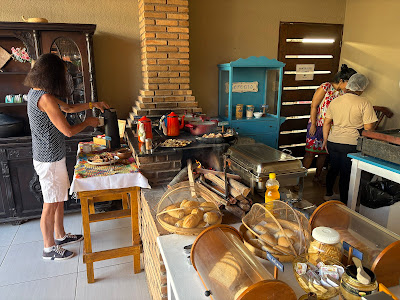This is the final leg of our 3-week trip to northeast Brazil, and the final installment of this blog.
We spent four nights in a small, very old pousada in Olinda, a beautiful, hilly city next to Recife, the huge 3.7 million-person capital of the state of Pernambuco. What a contrast there is between the two places, although they are so close to each other. Olinda has small twisty, cobbled streets and steps, and the houses are extravagantly painted in wild colors, often with dramatic murals. There are dozens of old churches, many in a state of near collapse or terminal mildew. There is also a very lively market with many interesting art and craft stalls, woodcarvings and lace-making, as well as the inevitable plethora of tapioca stands. Olinda is very green, with fruit trees and vines growing everywhere, even out of cracks in the roofs of buildings.
We spent our first day exploring Olinda, and visited one notable 16th century Franciscan monastery, its walls covered with blue Portuguese tiles depicting the life of St Francis, including parrots, peacocks and monkeys. St Francis loved animals according to legend, but we are pretty sure he never met a parrot.
We regularly did our walking and sightseeing in the mornings after a substantial breakfast and before the heat became too brutal. By noon we were ready to retire to our air-conditioned room for a few hours, before heading out for an evening stroll, and sometimes a bowl of açaí sorbet.
Despite the fact that Olinda is a well-known and picturesque tourist destination we rarely ran across other non-Brazilian visitors, and even Brazilians were thin on the ground. Apparently we were visiting in the post-carnival low season. This led to the problem of finding an open restaurant in the evening — most were closed or only open at weekends. However we did find some excellent, quiet places to enjoy delicious Brazilian food. Our favorite was a whole small pumpkin filled with a “soup” of shrimps, coconut milk and delicious if unidentified spices.
Feeling quite adventurous one morning, we took a local bus into Recife to visit some of the sights. We were lucky to encounter a young passenger who was adept with Google Translate and directed us to the stop to get off and change to another bus line. Our encounters with young Brazilians have been very positive and rewarding.
Recife is a big, messy city with some beautiful modern buildings, but on the whole it was a disappointment — trashy, grungy and grubby. We visited a couple of the top tourist attractions in the old town but were less than impressed.
Our final Olinda day involved a long Uber ride into a remote area of rain forest in the Recife suburbs, where we visited one of the most amazing art museums we have ever seen — the Oficina Cerâmica of Francisco Brennand. He was a reclusive and prolific ceramicist who worked mostly in the 1960 - 90 period. He inherited a ceramic factory from his father, and spent his life creating and displaying inside and outside thousands of huge, complex and weird ceramic sculptures and structures, based on mythology, imaginary animals, abstract shapes, and artistic interpretations. We won’t try to describe any more — there are a few photos below. The museum significantly rehabilitated our impression of Recife.
Our last few hours in Olinda were eventful, with a series of violent thunderstorms that caused the hotel roof to leak, and flooded the streets on the way to the airport. A misunderstanding about plane times and airport gates caused us to miss our flight to Fernando de Noronha, but we were able to rebook and arrived on this small, remote island only a few hours late. Fernando is about 200 miles off the coast of Brazil, and is the tip of a huge submerged volcano. As a result the coast is black volcanic rock interspersed with beautiful white-sand beaches and tall rocky pinnacles. Most of the island and nearly all the surrounding reefs and islets are part of a national park, so much of it is inaccessible.
We are here for 5 nights, and are staying at a beautiful little pousada surrounded by tropical vegetation. There is only one road across the island served by a regular and free bus service, so we are becoming adept at getting around. It would be hard to get lost in such a small place, with only 3,000 regular inhabitants. We are so far east that we have only a 2 hour time difference with London, and 3 hours in the other direction from Philadelphia.
Charles Darwin visited on his famous Beagle voyage and was disappointed in the lack of interesting bird life. However, the cliffs and outcrops are alive with boobies, noddies, terns and beautiful tropicbirds. This is a wonderful place to relax in the shade with a pair of binoculars. We are being quite careful not to get exposed to too much sun, as we are only 4 degrees south of the Equator. We have been in the sea up to our knees, but no further — the surf is huge and dangerous. Also, Noronha is famous as a breeding place for many species of sharks. We also came across multiple nests of turtle eggs waiting for the full moon to hatch. Because the island is so isolated and small, everything is imported, except for fish, and we have been enjoying dinners of various local fish dishes .
This is a perfect place to end our holiday — fascinating, relaxing and friendly.
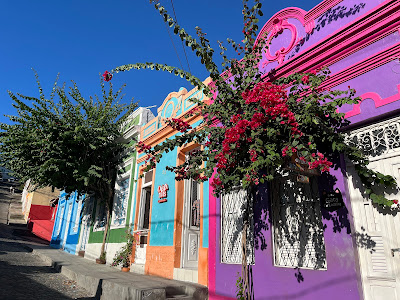 |
| Olinda houses |
 |
| View from our hotel window |
 |
| More Olinda houses |
 |
| Pumpkin with shrimps — Jerimum |
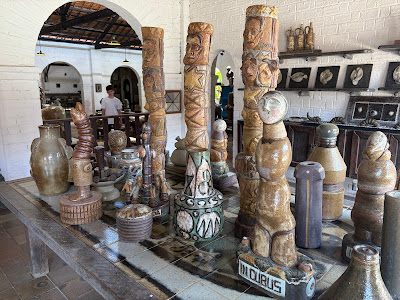 |
| Francisco Brennand ceramics |
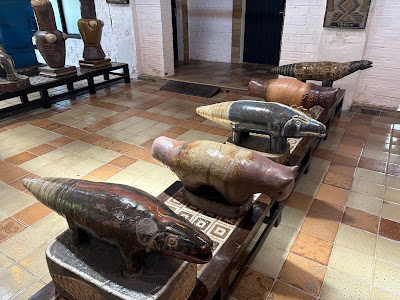 |
| Brennand fantastic animals |
 |
| Courtyard — it’s ALL ceramic |
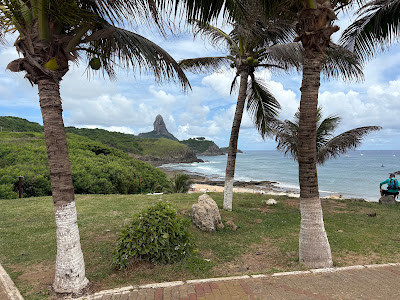 |
| Fernando de Noronha |
 |
| Sand, rock, surf |
 |
| Empty beach with black rocks |
 |
| Brazil’s favorite snack — tapioca |
 |
| Another reason to stay out of the water |

